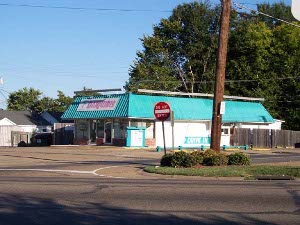 Louisiana daiquiri stand
share interests from mathematics to French culture and language.
Louisiana daiquiri stand
share interests from mathematics to French culture and language.
Why does a chicken cross the road? So it can be the lead sentence in our letter! We have learned to be alert for sluggish buzzards and for curious dogs, but it was brake-jamming time when a large white chicken sprinted across the road just ahead of us. We were, after all, about the only car around, and it was a narrow road, but it was thrilling, both for us and the chicken.
Realizing that we had only a few days to re-visit Cajun cuisine, we stopped at Prejean's in Lafayette for crawfish etouffee, fried crawfish, crawfish bisque, seafood gumbo, and crawfish pie. And dirty rice. Maque choux, a side dish, was a kind of corn pie. Prejean's decor features stuffed animals - Louisiana, after all, is nicknamed Sportsman's Paradise. Just inside the door, a 900-pound, 13-foot stuffed alligator catches the visitor's eye immediately.
Next day we were given the best of Louisiana hospitality by Roger and May in Lafayette, where we enjoyed the greenery in the Autumn sun on their patio, then were fed a breakfast of luscious casserole and fruit. We always enjoy comparing notes with them - both are many-faceted people, with whom we  Louisiana daiquiri stand
share interests from mathematics to French culture and language.
Louisiana daiquiri stand
share interests from mathematics to French culture and language.
On this visit we learned about spider lilies, which we had seen earlier in several front yards and field. These exotic flowers, bright red on a long leafless stalk, produce green leaves in the spring. In Autumn, the leaves die off but the flowers burst forth in a brilliant, unmistakable red. As May says, you can pass a vacant lot and see rows of spider lilies, and understand where a porch or a walkway once stood.
Louisiana has a new regional specialty: drive-through frozen daiquiri stands. Now if the DUI fines could go high enough, they might be able to finance the entire state government just from the revenue on football weekends!
Wandering north on narrow country roads, we still found signs of high-tech: a young boy riding bareback on his tall horse was talking into his cell phone.
As we moved north, we found more farming: hay, sugar cane and cotton, plus the expected herds of cows and occasional goats. On one tiny back road,  Louisiana zebra
we saw a bunch of donkeys, then noticed some stripier animals nearby in the same field -- yup, they were zebras.
Louisiana zebra
we saw a bunch of donkeys, then noticed some stripier animals nearby in the same field -- yup, they were zebras.
The only national forest in Louisiana is small, separated into several disjoint sections. Like other national forest lands, it is occupied by homes and industries, especially logging, but the woodlands gave us pretty views as we followed the increasingly hilly road.
We have been uncomfortably warm for all of September, but this morning we enjoyed mild temperatures and a light breeze. Now if we could escape the lovebugs who provided an entire new coat for the front of the car, we'd be truly content.
Pine Bluff, Arkansas, is clearly a city whose past is more prosperous than its present, at least downtown, where the major roads are all one-way but carry almost no traffic, the principal old businesses are largely boarded up, and the only high-rise is one bank building.
The Band Museum occupies one large storebuilding right in the center of town. As we entered, the proprietor was demonstrating several different  Bell signal horn
horns to a group of high school boys. As he drew powerful sounds from the old instruments, the boys seemed impressed. So were we. This museum is the creation of a retired Band Director and music store proprietor who is also clearly a dedicated collector of musical instruments. The city deeded the building to him in return for the establishment of his museum, of which he is the curator and guide. Among his treasures are a horn once played by Louis Armstrong, some old and some new instruments (he tries to concentrate on instruments made during and before the 1940's, because since that time there haven't been many changes to the design or construction of the instruments); and some very odd horns, with elaborate bells and extra curlicues.
Bell signal horn
horns to a group of high school boys. As he drew powerful sounds from the old instruments, the boys seemed impressed. So were we. This museum is the creation of a retired Band Director and music store proprietor who is also clearly a dedicated collector of musical instruments. The city deeded the building to him in return for the establishment of his museum, of which he is the curator and guide. Among his treasures are a horn once played by Louis Armstrong, some old and some new instruments (he tries to concentrate on instruments made during and before the 1940's, because since that time there haven't been many changes to the design or construction of the instruments); and some very odd horns, with elaborate bells and extra curlicues.
We found the museum a welcome change from the far more common historical museums, marveling at the instruments and chatting with this gentleman of many interests, even though the real 1940s soda fountain wasn't in business this day. It seems that he worked as a soda jerk in the 1940s and when he had the opportunity to collect the stools, counter, large mirror and soda-making equipment, he jumped at the chance, so the back room of The Band Museum contains his soda fountain. We can't help wondering what additions he may be planning!